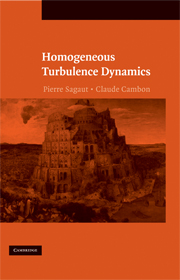Book contents
- Frontmatter
- Contents
- Abbreviations Used in This Book
- 1 Introduction
- 2 Statistical Analysis of Homogeneous Turbulent Flows: Reminders
- 3 Incompressible Homogeneous Isotropic Turbulence
- 4 Incompressible Homogeneous Anisotropic Turbulence: Pure Rotation
- 5 Incompressible Homogeneous Anisotropic Turbulence: Strain
- 6 Incompressible Homogeneous Anisotropic Turbulence: Pure Shear
- 7 Incompressible Homogeneous Anisotropic Turbulence: Buoyancy and Stable Stratification
- 8 Coupled Effects: Rotation, Stratification, Strain, and Shear
- 9 Compressible Homogeneous Isotropic Turbulence
- 10 Compressible Homogeneous Anisotropic Turbulence
- 11 Isotropic Turbulence–Shock Interaction
- 12 Linear Interaction Approximation for Shock–Perturbation Interaction
- 13 Linear Theories. From Rapid Distortion Theory to WKB Variants
- 14 Anisotropic Nonlinear Triadic Closures
- 15 Conclusions and Perspectives
- Bibliography
- Index
7 - Incompressible Homogeneous Anisotropic Turbulence: Buoyancy and Stable Stratification
- Frontmatter
- Contents
- Abbreviations Used in This Book
- 1 Introduction
- 2 Statistical Analysis of Homogeneous Turbulent Flows: Reminders
- 3 Incompressible Homogeneous Isotropic Turbulence
- 4 Incompressible Homogeneous Anisotropic Turbulence: Pure Rotation
- 5 Incompressible Homogeneous Anisotropic Turbulence: Strain
- 6 Incompressible Homogeneous Anisotropic Turbulence: Pure Shear
- 7 Incompressible Homogeneous Anisotropic Turbulence: Buoyancy and Stable Stratification
- 8 Coupled Effects: Rotation, Stratification, Strain, and Shear
- 9 Compressible Homogeneous Isotropic Turbulence
- 10 Compressible Homogeneous Anisotropic Turbulence
- 11 Isotropic Turbulence–Shock Interaction
- 12 Linear Interaction Approximation for Shock–Perturbation Interaction
- 13 Linear Theories. From Rapid Distortion Theory to WKB Variants
- 14 Anisotropic Nonlinear Triadic Closures
- 15 Conclusions and Perspectives
- Bibliography
- Index
Summary
Observations, Propagating and Nonpropagating Motion. Collapse of Vertical Motion and Layering
Turbulent flows can transport passive scalars, such as temperature or concentration. In important applications, such scalar (e.g., temperature, salinity) fluctuations generate a buoyancy force in the presence of gravity, which directly affects the velocity field. In addition, the transport of such “active” scalars by turbulence is altered by a mean-density gradient – intimately related to a mean-scalar gradient – in many applications, especially in atmospheric and oceanic research.
A first sketch of what stable and unstable stratifications are can be understood from a simple displaced-particle argument, as follows. Considering a vertical negative mean-density gradient (the heaviest flow is at the bottom), as in the scheme in Fig. 7.1, if a fluid particle is displaced upward, keeping its density and initially in hydrostatic equilibrium, it must experience a lighter fluid environment: The imbalance between (smaller) buoyancy and (same) weight will result in a downward force. The opposite situation occurs if the particle is moved downward, the imbalance buoyancy–weight will result in a upward force. Accordingly, the buoyancy force acts as a restoring force in this situation of negative mean-density gradient. Vertical oscillations with a typical frequency N are expected (as subsequently rediscussed).
- Type
- Chapter
- Information
- Homogeneous Turbulence Dynamics , pp. 219 - 242Publisher: Cambridge University PressPrint publication year: 2008



